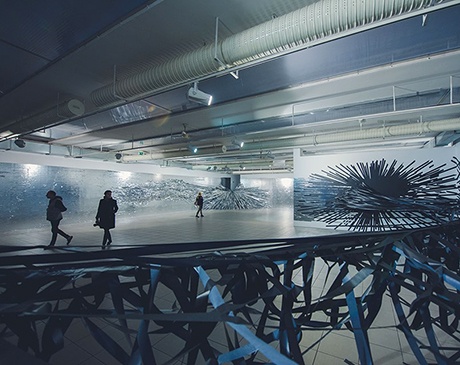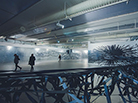Monika Grzymala / Damien Deroubaix. On the Nature of The World

We kindly invite you to the opening of the exhibition 18th October 2019 at 6 pm. Free entry. Join us!
Exhibition as part of the 28th Ars Cameralis Festival.

Indeed scattered abroad in my verses you see many letters common to many words, and yet you must needs grant that verses and words are unlike both in sense and in the ring of their sound. So great is the power of letters by a mere change of order (…)
Lukretius On the Nature of Things
Several Remarks on O naturze świata (On the Nature of the World) by Monika Grzymala and Damien Deroubaix
Not only does every one of us hide unique values within, but we also hide an image of the world which is in constant movement and continually keeps changing. The image of the world which for every one of us takes on a mysterious form of one’s own unique landscape, undoubtedly filled with signs of continually colliding opposites. Within this landscape, insatiability and the absorption of existence become manifestly present, while on the other hand this insatiability and absorption become superimposed with images of passing and with longing for a return to the harmony of time and form. In effect, we are condemned to a permanent process of adjusting and engaging in never-ending attempts at describing and understanding our imaginings about reality. In the changing kaleidoscope of the world we seek new ways of expression and we try to comprehend the existential experience, including our convictions related to the world view, desires, feelings, values, and ideals.
A statement saying that art is the best space in which to examine and follow paradoxes of the world is trivial. It is precisely within art that the struggle of opposites assumes a universal nature, it is thanks to art that we discover the weight of the world in the most palpable presence. Through images, colours, sounds, figures, and forms, art becomes an opening allowing us to catch a glimpse of that which seems impossible to be represented. Art is the moment during which we receive the radiance and luminosity of different variants of history, but also an image of unrest, wraiths of the past, and shadows which are yet to come. Art is the space (or time-and-space continuum) which retains this process, inciting in us an expectation for the narration to develop further.
Monika Grzymala and Damien Deroubaix are artists of the present time, yet their art undoubtedly stems from the times gone by. It was, first and foremost, initiated by the set of problems characteristic of the past century when, as Kandinsky put it: “Suddenly the sturdiest walls collapsed. Everything became uncertain, unsteady, and soft”. The time which forced and continues to force artists to unceasingly search for specific new practices in relation to the changing world.
Damien Deroubaix guides us into the world of diagrams, symbols, thoughts where the image of figures, items, and nature is very expressive and sharp, while it simultaneously acquires a dimension distorted by multiplication and echoes of repetition, as well as an understatement of their shape. The artist introduces us into a narrative sequence, characteristic for its dynamic gesture which the very same instant is subject to a procedure of simplification. He drafts, exposes, ornaments, and deconstructs his representations; he oftentimes behaves as if he were a director on the film set — that which is represented does not acquire the status of a presented element (montré), but is elevated (monté). It, however, opens the space within which we are faced with something that becomes more of a simulacra than phantasms inscribed in the discourse of memory.
Monika Grzymala performs a simple act: she separates the content from the form, the palpable matter from the represented value. Through a combination of lines and forms, she attempts to liberate herself from the surrounding reality. Through tapes formed with her hands, she builds a new time-and-space continuum, arranges a new architecture. Each of these lines becomes a quivering record of her experience and presents the artist’s relationship with the surrounding reality. Maintaining distance, Grzymala takes advantage of the strict knowledge, subordinating her statement to the painter’s presentation. In reality, however, there is only one work, it constitutes a record of her sensitivity: it is the unity of feeling, expression, and form presented to the viewer as spatial sculptures. Paradoxically, the artist leads us towards or draws our attention to the borderline between the space of the visible and invisible, this way also undermining our aesthetic habits.
During the journey that Grzymala and Deroubaix invite us to participate in, we will not avoid entering the historical time, which, to a substantial degree, allows us to disentangle the sequences of meanings. One must, however, be aware of the fact that we will have to face the symbolic and abstract nature of representations which are under the sway of the artists’ creative imagination. The spectre of Pablo Picasso’s Guernica, his reaction to the Nazi bombing of the Basque capital in Spain in 1937, floats above the entire exhibition. Until today, Guernica is held within a dimension of a shocking painting-manifesto, at the same time provoking much controversy. Many years after Picasso created his work, Mieczysław Porębski stated that it is large, flat, and empty. It is baffling that this prominent theoretician in his critical idea failed to notice that Guernica is a sequence of values, that it designates and determines contemporary art. Picasso may triumph again while his unusual sense provides us with something akin to an apotrapaion: it becomes an agent protecting against the forces of evil. The work of the Spanish artist is as if a magical object within which representations of demonic animals, caricatural faces, and entangled lines forming peculiar ornaments were to protect against an impending calamity. Monika Grzymala and Damien Deroubaix have a different sensitivity and experience, another way in which to express emotions, and also, undoubtedly, a differing world view. Yet, as a philosopher once stated: Iliad is simple and pathetic, in turn Odyssey is tangled and ethical.
Curator — Marek Zieliński





